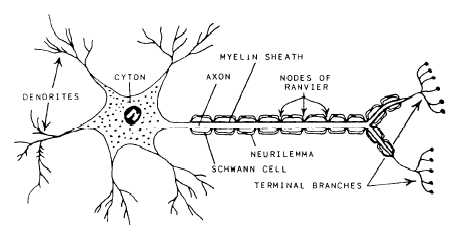BRADYPNEA is abnormal slowness of breathing.
TACHYPNEA is excessive rapidity of respiration.
HYPOPNEA is abnormal decrease in the depth and rate of the respiratory movements.
DYSPNEA is labored or difficult breathing.
HYPERPNEA is abnormal increase in the depth and rate of the respiratory movements.
APNEA is cessation of breathing.
CHEYNE-STOKES RESPIRATION are respirations that increase with force and frequency up to a certain point, then decrease until they cease altogether. After a short period of apnea, the respirations begin again, and the cycle is repeated.
STERTOROUS RESPIRATION is breathing with abnormal snoring sounds.
RALES are abnormal respiratory sounds, either moist or dry depending upon the fluid in the air passages, which are classified according to their location as bronchial or laryngeal rales.
RHONCHUS is a rattling sound in the throat due to partial obstruction; it is also a dry, coarse rale in the bronchial tubes.
THE NERVOUS SYSTEM
To effectively support human life, the activities of all the widely diverse cells, tissues, and organs of the body must be monitored, regulated, and coordinated. The interaction of the nervous and endocrine systems provides the needed control.
The nervous system is specifically adapted to the rapid transmission of impulses from one area of the body to another. On the other hand, the endocrine system, working at a far slower pace, maintains body metabolism at a fairly constant level.
In this section we will study the structure and functions of the nervous system.

Figure 3-38 .—The neuron and its parts.
THE NEURON
The structure and functional unit of the nervous system is the nerve cell, or neuron, which can be classified into three types. The first is the sensory neuron, which conveys sensory impulses inward from the receptors. The second is the motor neuron, which carries command impulses from a central area to the responding muscles or organs. The third type is the interneuron, which links the sensory neurons to the motor neurons.
The neuron is composed of dendrites, a cyton, and an axon (fig. 3-38). The DENDRITES are thin receptive branches, which vary greatly in size, shape, and number with different types of neurons. They serve as receptors, conveying impulses toward the cyton. The CYTON is the cell body containing the nucleus. The single, thin extension of the cell outward from the cyton is called the AXON. It conducts impulses away from the cyton to its terminal filaments, which transmit the impulses to the dendrites of the next neuron.
IMPULSE TRANSMISSION When dendrites receive a sufficiently strong stimulus, a short and rapid depolarization of the
